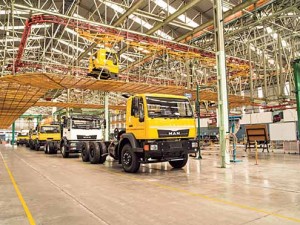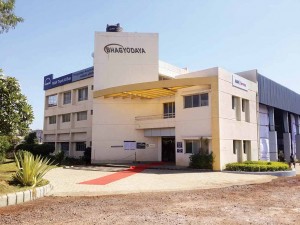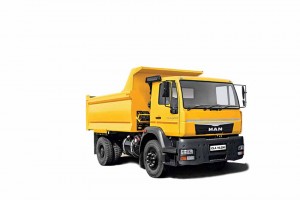MAN Trucks India has reiterated its position as the Asia hub for its principal, the MAN Group.
Story by: Ashish Bhatia
Reiterating its position as the Asia hub for the MAN Group, MAN Trucks India is looking to contribute 10 per cent of MAN’s total factory output over the next three-to-four years. The strategy seems to be not so much about achieving higher sales as much as it is about achieving higher production numbers. The manufacturing facility of MAN Trucks India at Pithampur has the capacity to manufacture 9,000 to 10,000 Cargo Line Asia (CLA) range of trucks in the 16- to 49-tonne segments, and front engine bus chassis measuring 12 m in length. Though the name CLA may suggest flaunting this that the trucks – are about Asia, they are in fact, exported as CKD kits to a MAN joint venture in Uzbekistan; to South Africa, and to the neighbouring countries. To achieve the 10 per cent target, the company is looking at invading new African markets, the Middle East, and East Asian countries like Malaysia, Philippines and Indonesia. Expressed Jeorg Mommertz, Chairman and Managing Director, MAN Trucks India, “The target to contribute 10 per cent of MAN’s total factory output over the next three-to-four years will be inclusive of the 50 per cent export volumes we wish to attain from India.” Poised to play a pivotal role in MAN’s global growth strategy, the only market the company is not looking at is Russia, which requires a operating guarantee under extreme climatic conditions like temperature as low as (-) 51 degree centigrade.
CLA for Asia and beyond
Planning to widen the scope of Cargo Line Asia (CLA) trucks, which were initially conceived for Asia, MAN Trucks India is eyeing the premium segment too. While the mid-premium segment, the premium segment could be invaded with global models like the TGE, TGL and the new Lion.According to Mommertz, MAN Trucks India is looking at the 300 hp market to deliver a certain payload and fuel efficiency. “We want to attain the highest possible payload and best-in-class fuel economy. It will help us to convince our customers in India of a value for money proposition,” he mentioned. Aware of GST influencing a market shift to higher tonnage CVs, Mommertz is keen to carve out a greater pie of the Medium and Heavy Commercial Vehicle (M&HCV) segments. Both, at the mid-premium and premium level. Stress is upon leveraging the high level of localisation (of up to 82 per cent) the CVs made in India have come to have. At 2015 Excon, the company announced the launch of the Evo range of CVs. They mark a CLA face-lift, and are powered by the D08 engine family. Confident of the Indian products reflecting core MAN values of, the MAN Trucks India is updating the (CLA) range to better address the market need.
A large chunk of MAN trucks in India is tippers as of current. The higher hp engine helps. What is however seeming to limit the company’s ability to set the sales charts on fire is the higher price positioning. If the higher price positioning is claimed to limit the play-ability, the thrust of the government to boost infrastructure in India may result MAN Trucks India to invade long-haul segments. In India, MAN also operates in the ODC segment, and special application segments like fire tenders, garbage compactors, concrete mixers, boom pumps, tip-trailers and bulkers. Last year the company supplied a fair number of fire tenders and special application trucks to the Brihanmumbai Municipal Corporation. The R&D centre at Pune is said to help the company to address such needs. Selling over 25000 trucks till date, MAN Trucks India has come to operate through a network of 64 dealers in India, and a dealer each in Bangladesh, Nepal and Bhutan. According to Mommertz, there is a need to attain high quality at competitive costs. Describing MAN trucks as high-endurance machines, Mommertz stated, “Trucks sold in 2006 are still in operation in Kochi. They are a testimony to the reliability of a MAN truck.” We have also had our trucks operate in sub zero degree temperatures in India, he mentioned.
New technologies to increase market share
Of what is produced at Pithampur, 40 per cent is exported. This may translate into 35 per cent plant utilisation Year-To-Date (YTD). The target is to achieve an output of 50,000 units per annum through a gradual ramp up of 3 per cent to 3.5 per cent per year. Tractor trailers currently constitute 60 per cent of the overall business volume. Their share is expected to rise. Said Mommertz, that the regime will materialise demand for long-haul trucks, which translates into a 20 hour duty cycle, and 40 per cent higher round-trip efficiency.
If the higher horse power and tougher build will make a strong business case for MAN Trucks India, the talks with suppliers are proceeding as expected according to Mommertz. They are expected to result in the company offering new technologies like AMT to its customers to achieve higher level of business efficiency. The company, said Mommertz, is looking at localising the CLA fire tenders. Having supplied them to Mumbai, the company is confident of a good play.
Employing SCR technology to meet BSIV emission norms, MAN Trucks India, following the Product Cost Optimisation (PKO) process it has inherited from its principal, is keen to meet the 10 per cent production contribution target sooner than later. Holding a key position in MAN Group’s global growth endeavour, MAN Trucks India, claimed industry sources, will create awareness about its products. It can no longer be satisfied with the amount of market share – domestic and export, that it has. Stressing upon performance, productivity and profitability, Mommertz said that the products the company will offer will guarantee low total cost of ownership. Up-time improvements are being worked upon by restructuring the support network, he explained. Of the opinion that hardware investments and the life of a truck are a petty 15 per cent of the overall operational costs, Mommertz said, “Transport business in India is highly competitive. While the short-to-medium focus areas continue to be truck-tractor and haulage, our long-term strategy entails a look at the sub-16 tonne segment.” There is some time before MAN Trucks India formulates a strategy for this, it seems. If the strategy will strike a synergy with Volkswagen of which it is a part, or with Scania, which is also a Volkswagen Group company, will be too early to be delved upon. Processes like common sourcing are already in place, and are expected to profit MAN Trucks India as it buckles up to play a more decisive role in the scheme of things at MAN Group.
























